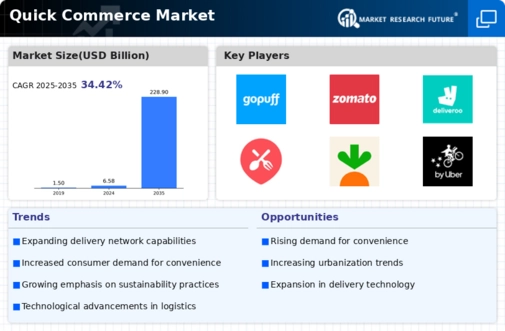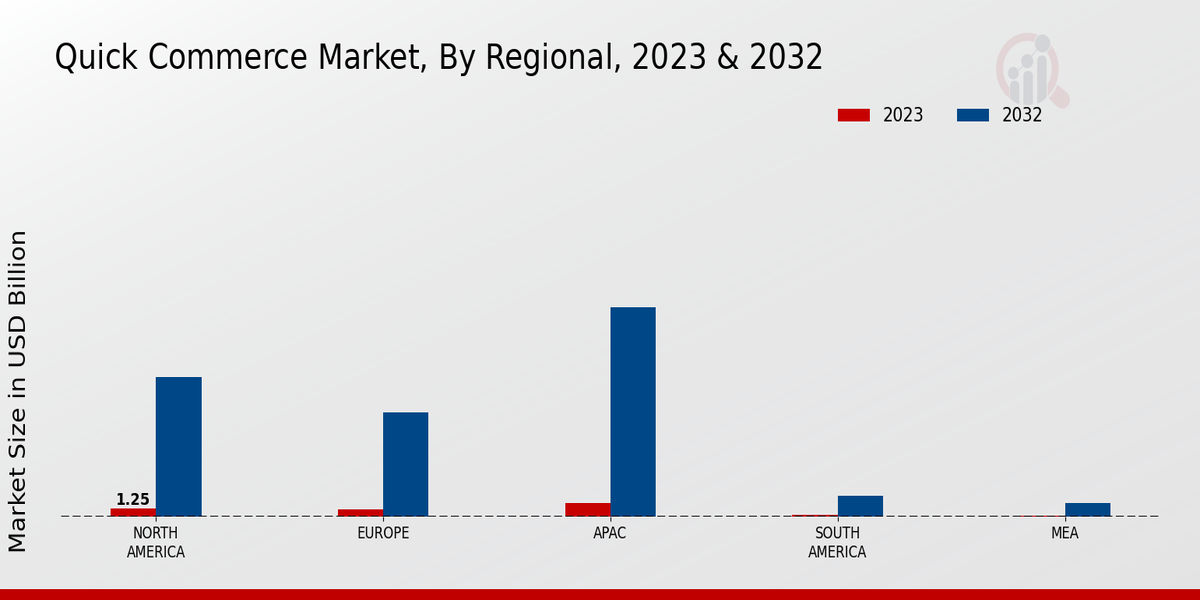Market Growth Projections
The Global Quick Commerce Market Industry is poised for substantial growth, with projections indicating a market value of 6.58 USD Billion in 2024 and an anticipated increase to 228.9 USD Billion by 2035. This remarkable growth trajectory suggests a compound annual growth rate (CAGR) of 38.08% from 2025 to 2035. Such figures underscore the industry's potential and the increasing importance of quick commerce in the global economy. The rapid expansion reflects evolving consumer behaviors and the ongoing integration of technology in logistics and delivery services.
Expansion of E-commerce Platforms
The expansion of e-commerce platforms significantly influences the Global Quick Commerce Market Industry. As more consumers turn to online shopping, companies are compelled to offer quick delivery options to remain competitive. The rise of mobile applications and user-friendly interfaces facilitates seamless shopping experiences, driving consumer engagement. This trend is expected to contribute to the market's growth, with projections indicating a value of 228.9 USD Billion by 2035. The integration of quick commerce services into established e-commerce platforms may further enhance market penetration, creating a symbiotic relationship between the two sectors.
Rising Consumer Demand for Convenience
The Global Quick Commerce Market Industry experiences a notable surge in consumer demand for convenience-driven services. As urban populations grow, consumers increasingly seek rapid delivery options for everyday essentials. This trend is evidenced by the projected market value of 6.58 USD Billion in 2024, reflecting a shift in purchasing behavior. Companies are adapting by enhancing their logistics and supply chain capabilities to meet these expectations. The emphasis on convenience is likely to drive innovation in delivery methods, such as drone and autonomous vehicle usage, further solidifying the industry's growth trajectory.
Technological Advancements in Logistics
Technological advancements play a pivotal role in shaping the Global Quick Commerce Market Industry. Innovations in logistics technology, such as real-time tracking systems and automated warehousing, enhance operational efficiency and customer satisfaction. These technologies enable companies to optimize delivery routes and reduce lead times, which are critical in a market that values speed. As a result, businesses are likely to invest heavily in these technologies, contributing to the industry's projected growth. The integration of artificial intelligence and machine learning into logistics operations may further streamline processes, potentially increasing market competitiveness.
Increased Investment in Delivery Infrastructure
Investment in delivery infrastructure is a critical driver for the Global Quick Commerce Market Industry. Companies are increasingly allocating resources to enhance their logistics networks, including the establishment of micro-fulfillment centers and partnerships with local delivery services. This investment is essential to meet the rising consumer expectations for faster delivery times. As the market evolves, the focus on building robust infrastructure is likely to yield significant returns, as evidenced by the anticipated CAGR of 38.08% for the period from 2025 to 2035. Such developments may also foster competition among players, further accelerating market growth.
Changing Consumer Preferences Towards Sustainability
Changing consumer preferences towards sustainability are reshaping the Global Quick Commerce Market Industry. As environmental concerns gain prominence, consumers increasingly favor companies that adopt eco-friendly practices. This shift is prompting businesses to explore sustainable packaging solutions and carbon-neutral delivery options. Companies that align their operations with these values may enhance their brand loyalty and attract a broader customer base. The emphasis on sustainability could also lead to innovative practices within the industry, potentially influencing market dynamics and growth patterns in the coming years.















